
The Hygrophoraceae are a family of fungi in the order Agaricales. Originally conceived as containing white-spored, thick-gilled agarics, including Hygrophorus and Hygrocybe species, DNA evidence has extended the limits of the family, so it now contains not only agarics, but also basidiolichens and corticioid fungi. Species are thus diverse and are variously ectomycorrhizal, lichenized, associated with mosses, or saprotrophic. The family contains 34 genera and over 1000 species. None is of any great economic importance, though fruit bodies of some Hygrocybe and Hygrophorus species are considered edible and may be collected for sale in local markets.

Hygrocybe is a genus of agarics in the family Hygrophoraceae. Called waxcaps in English, basidiocarps are often brightly coloured and have dry to waxy caps, white spores, and smooth, ringless stems. In Europe they are characteristic of old, unimproved grasslands which are a declining habitat, making many Hygrocybe species of conservation concern. Four of these waxcap-grassland species, Hygrocybe citrinovirens, H. punicea, H. spadicea, and H. splendidissima, are assessed as globally "vulnerable" on the IUCN Red List of Threatened Species. Elsewhere waxcaps are more typically found in woodlands. Most are ground-dwelling and all are believed to be biotrophs. Around 150 species are recognized worldwide. Fruit bodies of several Hygrocybe species are considered edible and are sometimes offered for sale in local markets.
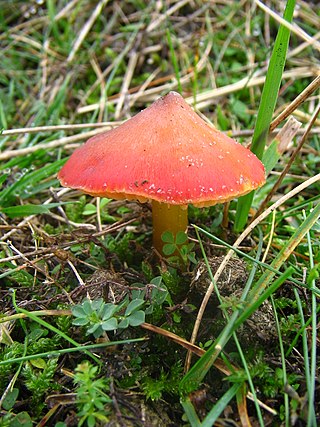
Hygrocybe conica is a species of agaric in the family Hygrophoraceae. In the UK it has been given the recommended English name of blackening waxcap, since all parts of the basidiocarp blacken with age. In North America it is commonly known as the witch's hat, conical wax cap or conical slimy cap. Hygrocybe conica is known to be a complex of at least eleven closely related species and as such is widespread in Europe, North America, Asia, and elsewhere.

Hygrocybe punicea is a species of agaric in the family Hygrophoraceae. It has been given the recommended English name of crimson waxcap. The species has a European distribution, occurring mainly in agriculturally unimproved grassland. Threats to its habitat have resulted in the species being assessed as globally "vulnerable" on the IUCN Red List of Threatened Species. Records of H. punicea from North America, East Asia, and Australia require further research to see if they represent the same species.
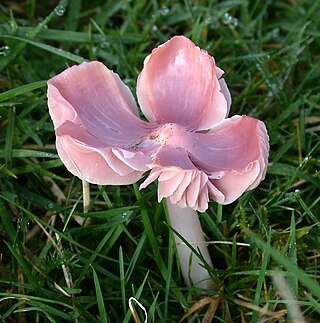
Porpolomopsis calyptriformis, commonly known as the pink wax cap, ballerina waxcap or salmon waxy cap, is a species of agaric in the family Hygrophoraceae. The species has a European distribution, occurring mainly in agriculturally unimproved grassland. Threats to its habitat have resulted in the species being assessed as globally "vulnerable" on the IUCN Red List of Threatened Species. A similar but as yet unnamed species occurs in North America.

Hygrocybe chlorophana is a species of agaric in the family Hygrophoraceae. It has been given the recommended English name of golden waxcap in the UK. The species has a largely north temperate distribution, occurring in grassland in Europe and in woodland in North America and northern Asia; it has also been reported from mountainous areas of southern Australia. It typically produces basidiocarps in the autumn. In a few European countries, H. chlorophana is of conservation concern, appearing on national red lists of threatened fungi.
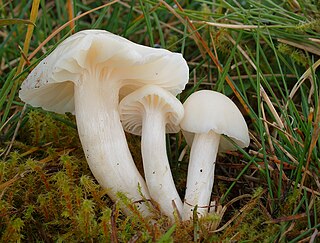
Cuphophyllus virgineus is a species of agaric in the family Hygrophoraceae. Its recommended English common name is snowy waxcap in the UK. The species has a largely north temperate distribution, occurring in grassland in Europe and in woodland in North America and northern Asia, but is also known from Australia. It typically produces basidiocarps in the autumn.

Cuphophyllus pratensis is a species of agaric in the family Hygrophoraceae. It has been given the recommended English name of meadow waxcap in the UK and in North America has variously been called the meadow waxy cap, salmon waxy cap, and butter meadowcap. The species has a widespread, mainly temperate distribution, occurring in grassland in Europe and in woodland elsewhere. The basidiocarps are edible and are occasionally collected and sold commercially.

Gliophorus irrigatus is a species of agaric in the family Hygrophoraceae. It has been given the recommended English name of slimy waxcap in the UK. The species is widespread in temperate regions, occurring in grassland in Europe and in woodland in North America and elsewhere.

Hygrocybe quieta is a species of agaric in the family Hygrophoraceae. It has been given the recommended English name of oily waxcap in the UK. The species has a European distribution and typically occurs in grassland where it produces basidiocarps in the autumn. In several countries, H. quieta is of conservation concern, appearing on national red lists of threatened fungi.

Gliophorus europerplexus is a species of agaric in the family Hygrophoraceae. It has been given the recommended English name of butterscotch waxcap. The species has a European distribution, occurring mainly in agriculturally unimproved grassland. Threats to its habitat have resulted in the species being assessed as globally "vulnerable" on the IUCN Red List of Threatened Species.

Gliophorus reginae is a species of agaric in the family Hygrophoraceae. It has been given the recommended English name of jubilee waxcap. The species has a European distribution, occurring mainly in agriculturally unimproved grassland. Threats to its habitat have resulted in the species being assessed as globally "vulnerable" on the IUCN Red List of Threatened Species.

Hygrocybe splendidissima, is a species of agaric in the family Hygrophoraceae. It has been given the recommended English name of Splendid Waxcap. The species has a European distribution, occurring mainly in agriculturally unimproved grassland. Threats to its habitat have resulted in the species being assessed as globally "vulnerable" on the IUCN Red List of Threatened Species.
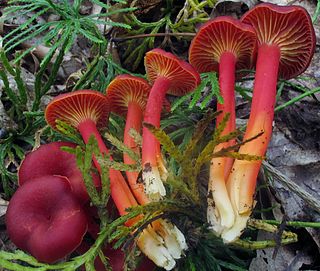
Hygrocybe appalachianensis, commonly known as the Appalachian waxy cap, is a gilled fungus of the waxcap family. It is found in the eastern United States, where it fruits singly, in groups, or clusters on the ground in deciduous and mixed forests. The species, described in 1963 from collections made in the Appalachian Mountains, was originally classified in the related genus Hygrophorus. It was transferred to Hygrocybe in 1998, in which it has been proposed as the type species of section Pseudofirmae.

Neohygrocybe ingrata is a species of agaric in the family Hygrophoraceae. It has been given the recommended English name of dingy waxcap. The species has a European distribution, occurring mainly in agriculturally unimproved grassland. Threats to its habitat have resulted in the species being assessed as globally "vulnerable" on the IUCN Red List of Threatened Species.

Hygrocybe citrinovirens is a species of agaric in the family Hygrophoraceae. It has been given the recommended English name of Citrine Waxcap. The species has a European distribution, occurring mainly in agriculturally unimproved grassland. Threats to its habitat have resulted in the species being assessed as globally "vulnerable" on the IUCN Red List of Threatened Species.

Neohygrocybe ovina is a species of agaric in the family Hygrophoraceae. It has been given the recommended English name of blushing waxcap, since the lamellae (gills) and flesh turn pinkish red when bruised. The species has a European distribution, occurring mainly in agriculturally unimproved grassland. Threats to its habitat have resulted in the species being assessed as globally "vulnerable" on the IUCN Red List of Threatened Species.

Hygrocybe aurantiosplendens, commonly known as the orange waxcap, is a gilled fungus in the family Hygrophoraceae. It mainly occurs in Europe, but is also found in Siberia, and on both the East and West coasts of North America. It is uncertain if the continental ecotypes are in fact conspecific and are sometimes treated as distinct species.
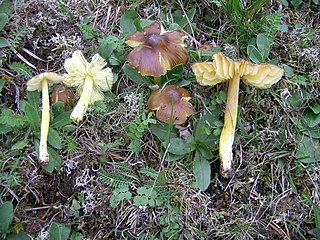
Hygrocybe spadicea is a species of agaric in the family Hygrophoraceae. It has been given the recommended English name of Date Waxcap. The species has a European distribution, occurring mainly in agriculturally unimproved grassland. Threats to its habitat have resulted in the species being assessed as globally "vulnerable" on the IUCN Red List of Threatened Species.



















